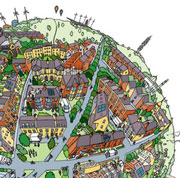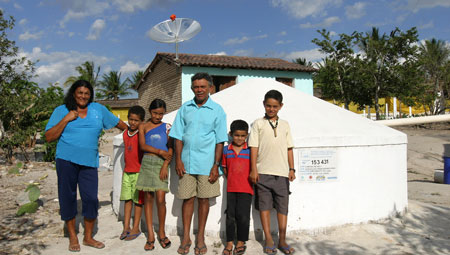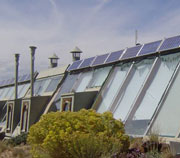This post is based on a contribution I’ll be making in a session on ‘scaling up’ at the OECD Symposium on Innovation and Inclusive Growth in Paris on 20-21 March 2014.
There has always existed an insistent undercurrent of grassroots innovation activity in societies. Whether born of material or economic necessity, or motivated by social issues marginalised by the conventional innovation systems of states and markets, networks of grassroots innovators have worked to find development solutions that meet the aims, interests, and situations of the activists, communities and individuals involved.

Lessons from the grassroots?An emerging agenda for
inclusive innovation amongst national and international development agencies has drawn elite attention to grassroots innovation. Grassroots innovation activity attracts interest as both a source of potentially inclusive ideas and practices, worthy of scaling-up, and as a relevant field of experience from which programmes for inclusive innovation might learn.
Research into grassroots innovation movements at the
STEPS Centre and in
SPRU for over a decade certainly suggests some relevant lessons. But the most important lessons are not as directly instrumental for inclusive innovation as some agencies might hope. Because whilst there is valuable experience in grassroots innovations, the main lessons from studying this field is that questions about scaling-up inclusive innovation might be misguided, or at least too narrow, and what is really required are answers to questions about opening-up and democratising innovation systems.
There are three motivating questions for the
OECD Symposium. This contribution addresses the second and third of them:
- What are the impacts of innovation and innovation policy on industrial, social and territorial inclusiveness?
- How can inclusive innovation initiatives be expanded to improve welfare and facilitate the democratisation of innovation?
- What are key implications for policy? What can be done to support the successful implementation of novel approaches to policy to effectively support inclusive growth?
My argument is that inclusive innovation may not automatically facilitate the democratisation of innovation. Indeed, the relationship may need to operate the other way: it is difficult to have deep and meaningful inclusion in innovation (and, by implication, fair and just exclusion) without first democratising innovation systems. Problematising question two in this way means that considerations for policies sought in question three begin to look quite different.
Scaling-up processes not objects?
Even if one approaches grassroots innovation with an interest in scaling-up inclusive innovation, further questions soon become apparent. Evidence from our own research does include attempts to develop promising grassroots innovations into scalable forms. Typically, this proceeds through measures to formalise and commercialise the innovation. The facilities and tools of conventional innovation systems are brought to the services of promising grassroots innovators and their innovations: through the provision of research, development and demonstration; assistance with standards procedures; and help securing intellectual property. Investment and marketing assistance is also provided. Amongst the more advanced examples of this is the
National Innovation Foundation in India.
So one can analyse in-depth the processes for developing and marketing goods and services arising from grassroots ingenuity. Models could be developed for inclusive innovations relevant to markets lower down the pyramid. However, this is a view that relates grassroots innovation to inclusion in terms of outputs only. The grassroots furnishes prototypes for the poor; and these are then turned into goods and services for scaling-up, principally by expanding markets. It is also a view that presumes an obvious risk-taking innovator (analogous to a firm or inventor) to support and reward, and an innovation that can be turned into a proprietary object. Of course, the inclusive innovations that result need not be marketed commercially to poorer consumers. Inclusive innovations might become products that are distributed through donor development programmes or social enterprises.
However, one of the key lessons from our research into grassroots innovation movements is that the people involved can be as much concerned about the processes of innovation as they are for the outputs of innovation. Grassroots innovators and their networks want to be involved in prioritising and framing the development issue, making design choices, decisions about evaluative criteria as well as evaluating ‘success’, undertaking further development and production, how investments are made, and any returns distributed or reinvested, as well as other aspects of the innovation process. Grassroots innovators are concerned about the
form, depth, and scope of inclusion in innovation; and they are creating spaces for experimenting with new forms of innovation process.
 |
Family with a Cisterna, Brazil. Photo: ASA Brasil
|
All of these are concerns that challenge the market-based approach to scaling-up inclusive innovation noted above. A good example here is experience with the
Cisterna programme for rainwater harvesting in Brazil. Cisterna involves the provision of household and larger-scale rainwater collection systems that can store sufficient water for families to get through the dry seasons in semi-arid North-Eastern Brazil. The programme emerged originally as a grassroots innovation. Local activists and engineers pioneered an assisted process for households and communities to build their own systems. It proved to be an innovation popular with communities in the region. Wanting to scale-up the use of rainwater harvesting, the government decided to purchase ready-made, plastic systems for more rapid installation locally.
However, these standard units did not work well in all situations – buckling under the intense heat in some cases. Just as significantly, simply installing this technology provided neither the space nor processes for development workers and local community members to address issues that affect how the systems would be used. Unlike the government view on scaling-up, the grassroots initiative was about more than providing families with water. There was a desire to address local power relations that affected not only access to water (and the injustices arising from reliance on water tanked in by vendors) but expand it to other development issues too. In its original form, Cisterna attempted through the organisation of the self-build process to build up capabilities for addressing social change, thereby giving people the confidence and power to organise themselves, articulate demands, do projects, and co-ordinate their maintenance. Protests in the region subsequently reinstated a self-build track into the programme.

We found a similar difference in breadths of purpose in studying
community energy projects in the UK. Again, the government has noticed grassroots activity and begun developing strategies and support schemes with a view to scaling-up initiatives. Again, however, the schemes are framed quite narrowly, this time around engaging publics in sustainable energy. Our research found the protagonists initiating community energy projects had a wider set of economic, social and political aims. These included building cohesion and solidarity in the community, enhancing the skills and employability of people, asserting ownership and democratic control over local renewable resources, local jobs and economic development, and becoming less reliant on centralised fossil energy. The aims were very context specific and varied project-by-project: contextual sensitivities that the scaling-up of standard community energy models or packages risks losing.
At stake here are differences in
framings of grassroots innovation. A more challenging framing sees grassroots innovation as providing a space for people to experiment, and in so doing build up power to do alternative developments in ways that challenge the structural priorities of incumbent innovation systems. An additional benefit to attending to inclusion in this way is that it opens up space to confront the gender, class, ethnicity, age and other relations that can sometimes be sources of exclusion, even in grassroots initiatives, and to figure out how an innovation process might be accompanied by other changes that ensure a more equitable and inclusive outcome. It has to be remembered that the communities within and across which grassroots innovation happens exhibit (and need to address) inequality, exclusions, and hierarchies just like the wider societies in which they are situated.
Innovation: exclusions, resistance and alternatives
Scaling-up is often seen in terms of
standardising. However, even where the process of standardisation is trying to result in more inclusive outcomes, the process can also exclude other original features.
Organic food, for example, was an early grassroots example where organisations like the Soil Association developed standards principally to assure authenticity and help with scaling-up. But what expanded was a set of standard and specific practices for cultivating crops and livestock. Synthetics-free ingredients scaled-up and were inserted into conventional food systems, rather than the original organic movement vision for local food economies based in mixed farms. Insufficient inclusion of the organic food vision prompted a reaction, in the reappearance of more localised organic food provision through box schemes, markets, and so forth. Practices in agro-ecology represent innovations that resist the encroachment of agricultural innovations based in high-input, capital-intense, industrialising food production and consumption. It is difficult to foresee inclusion operating smoothly across these two different worlds of innovation.
Other grassroots innovations arose similarly as ways of contesting the development pathways implied by incumbent innovation systems. As we see in areas of renewable energy now, such as for the Energiewende in Germany, once innovations grow beyond their grassroots origins, and concerns for ownership, empowerment and democratic control become more assertive, then they can present challenges to incumbent groups, and unsettle prevailing power relations. Sometimes, this leads to the co-option and reinvention of the innovation into forms more palatable to incumbents and their innovation systems. We get utility-scale renewable electricity plants rather than the decentralised electricity systems as envisaged by the pioneers under ownership of local communities. What could become inclusive innovation goes awry as the grassroots gets excluded through a scaling-up based in standardisation, loss of context and insufficient attention to power relations.
Debating the democratisation of innovation
So perhaps scaling-up is the wrong question? Scaling-up tends to frame the issue as one of extent and
quantity, which glosses over important points of contestation around directions and qualities of innovation. We need to think more carefully about different kinds of inclusions, various sources of exclusions, plural innovation pathways, and resistance and alternatives to incumbent systems. Moreover, we need to think about inclusion dynamically. Seeing inclusion in terms of correcting an exclusion and bringing (market) access to a service through an innovation, implies quite a settled view on innovation as providing fixes: the situation is ameliorated by a more inclusive provision of goods or service; the included passively welcome the innovation. However, as we see in the case of Cisterna, the intended beneficiaries might not be so pliant, they might demand more, or the innovation experience might reveal further points of contestation and generate new issues relevant to questions of inclusion and exclusion.
The argument made here accords with the symposium identification with supporting the democratisation of innovation, but it suggests such democratisation will not arise automatically through a technical policy framing of the problem in scaling-up inclusive innovations. We need to think about democratising innovation in much more political terms.
How might an agenda based around the democratisation of innovation differ from an inclusive innovation agenda? First and foremost, it would attend to the power relations involved in innovation: the power to do innovation, and power over innovation agendas. The discussion above about scaling-up involves power relations between the grassroots and innovation systems through the way grassroots novelties are selected and developed. Who is in control of these processes? What principles are in play over decisions and selections? Our research finds that grassroots innovators are interested in these questions. In a few cases, they articulate it as a question of democratising innovation, or practicing innovation for social justice. The symposium wants to identify key policy principles for innovation; perhaps they should be democracy and social justice?
Drawing on grassroots debates, then a democratising innovation agenda would address the opening-up of innovation systems. Practically, that means thinking of more democratic arenas for establishing research agendas, funding decisions, universities, research institutes, venture and investment capital, training and skills programmes, prototyping infrastructures, marketing, and so forth. It also means building networks and coalitions between these arenas, where the potential can be demonstrated through acts, amplified by lobbying, and win influence through alliances. These are political challenges about opening-up innovation systems, and making systems accessible to citizens.
The practical challenges are considerable and uncertain. One practical possibility arising from some grassroots initiatives suggests scaling–down innovation systems, and decentralising facilities and institutions to where people live. This has been attempted with science shops and technology networks in the past, for example, and is being explored through fablabs, hackerspaces and similar community-based workshops today. There are other practical steps that could be explored also, but there is not space to develop them here.
Whatever gets considered, experience suggests we need to guard against idealizing grassroots activism in design, experimentation, and development of innovations. People do not respond automatically to the provision of a material facilities and training programmes. The spaces need be in tune with the contexts in which people live: they have to be designed and cultivated carefully, through on-going community development processes. And people have to be supported in gaining confidence within these more structured spaces. Questions of inclusion, exclusion, participation, and so forth are just as pertinent in these grassroots spaces. Issues abound around expertise, knowing how and knowing what, skills, tacit knowledge, and practices that push the scope and flexibility of both high- and low-technological options. The point is that these spaces allow experimentation and learning in democracy itself and what democratising innovation can mean practically.
Some concluding remarks
Words are powerful. They frame thinking and action. Clearly, inclusive innovation is a term motivating a lot of work amongst policy agencies at the moment (responsible innovation and social innovation are other terms keeping agencies busy). The term inclusive innovation provides welcome recognition that the focus and fruits of innovation need to be redirected and redistributed. But it also raises questions about what is being included in innovation.
In this post I have tried to argue that we need to think about alternative terms, such as starting with democratising innovation systems. What might happen if the normative (yet not too threatening) goal of scaling-up inclusive innovation was replaced by aims to open-up innovation systems to more democratic processes? Grassroots innovation experience suggests this is a valid re-framing of the issue.
Arguably, such an opening-up might lead to more diverse, balanced, and distributed innovation systems and economic activity. A wider sense of ownership and empowerment over innovative activity might encourage responsible citizens, whose deliberations could, as some democratic theory argues, generate richer discourses and better decisions about innovation. We’ll only learn whether this is the case or not if we ask the right questions.
by
Adrian Smith







